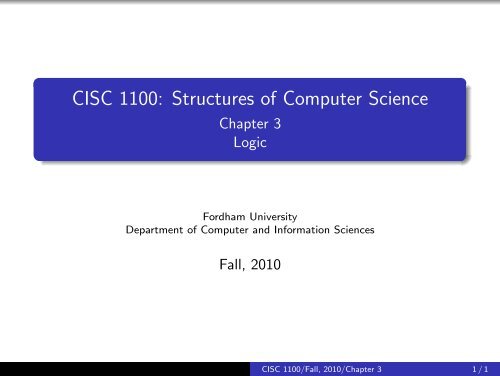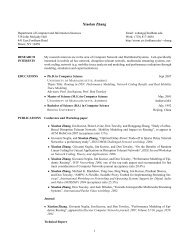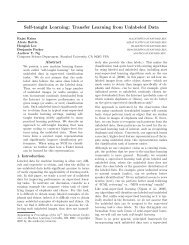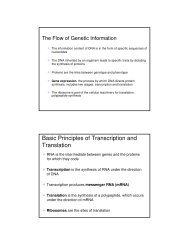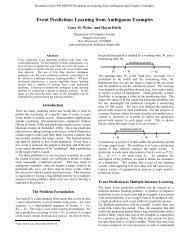CISC 1100 - Computer & Information Sciences - Fordham University
CISC 1100 - Computer & Information Sciences - Fordham University
CISC 1100 - Computer & Information Sciences - Fordham University
You also want an ePaper? Increase the reach of your titles
YUMPU automatically turns print PDFs into web optimized ePapers that Google loves.
<strong>CISC</strong> <strong>1100</strong>: Structures of <strong>Computer</strong> Science<br />
Chapter 3<br />
Logic<br />
<strong>Fordham</strong> <strong>University</strong><br />
Department of <strong>Computer</strong> and <strong>Information</strong> <strong>Sciences</strong><br />
Fall, 2010<br />
<strong>CISC</strong> <strong>1100</strong>/Fall, 2010/Chapter 3 1 / 1
Logical (or illogical) reasoning<br />
Is this a valid argument<br />
All men are mortal.<br />
Socrates is a man.<br />
Therefore, . . Socrates is mortal.<br />
Valid or not . . Yes!<br />
Is this a valid argument<br />
If we finish our homework, then we will go to the park.<br />
We are going out to the park.<br />
Therefore, we finished our homework.<br />
Valid or not . . No! . .<br />
How to recognize the difference<br />
<strong>CISC</strong> <strong>1100</strong>/Fall, 2010/Chapter 3 2 / 1
Outline<br />
Propositional Logic<br />
Logical operations<br />
Propositional forms<br />
From English to propositions<br />
Propositional equivalence<br />
Predicate logic<br />
Quantifiers<br />
Some rules for using predicates<br />
<strong>CISC</strong> <strong>1100</strong>/Fall, 2010/Chapter 3 3 / 1
Propositional logic<br />
Proposition: A statement that is either true or false:<br />
2 + 2 = 4. . .<br />
2 + 2 = 5. . .<br />
It rained yesterday in Manhattan. . .<br />
It will rain tomorrow in Manhattan. . .<br />
These are not propositions:<br />
x + 2 = 4. . .<br />
Will it rain today in Manhattan . .<br />
Colorless green ideas sleep furiously.<br />
<strong>CISC</strong> <strong>1100</strong>/Fall, 2010/Chapter 3 4 / 1
Propositional logic (cont’d)<br />
Truth value of a proposition (T, F) . .<br />
Propositional variables: lower case letters (p, q, . . . ) . .<br />
(Analogous to variables in algebra.)<br />
p=“A New York City subway fare is $2.25.”<br />
q=“It will rain today in Manhattan.”<br />
r=“All multiples of four are even numbers.”<br />
<strong>CISC</strong> <strong>1100</strong>/Fall, 2010/Chapter 3 5 / 1
Logical operations: negation<br />
Negation, the not operation: reverses a truth value.<br />
Negation is a unary operation: only depends on one variable.<br />
Negation of p is denoted ¬p.<br />
(Some books use other notations, such as p or p ′ .)<br />
Can display via a truth table<br />
p ¬p<br />
T F<br />
F T<br />
<strong>CISC</strong> <strong>1100</strong>/Fall, 2010/Chapter 3 6 / 1
Logical operations: conjunction, disjunction<br />
The remaining operations we discuss are binary operations:<br />
they depend on two variables (also called connectives). . .<br />
Conjunction, the and operation: true if both operands are<br />
true. Denote by ∧. . .<br />
Disjunction, the (inclusive) or operation: true if either<br />
operand is true (including both). Denote by ∨. . .<br />
Truth tables:<br />
p q p ∧ q<br />
T T T<br />
T F F<br />
F T F<br />
F F F<br />
p q p ∨ q<br />
T T T<br />
T F T<br />
F T T<br />
F F F<br />
<strong>CISC</strong> <strong>1100</strong>/Fall, 2010/Chapter 3 7 / 1
Logical operations: exclusive or<br />
The inclusive or ∨ is not the “or” of common language.<br />
That role is played by exclusive or (xor), denoted ⊕.<br />
Truth table:<br />
p q p ⊕ q<br />
T T F<br />
T F T<br />
F T T<br />
. .<br />
F F F<br />
<br />
Be careful to distinguish between or and xor!<br />
<strong>CISC</strong> <strong>1100</strong>/Fall, 2010/Chapter 3 8 / 1
Logical operations: conditional<br />
Denoted p ⇒ q. . .<br />
Captures the meaning of<br />
If p, then q.<br />
p implies q.<br />
p only if q.<br />
p is sufficient for q.<br />
q is necessary for p.<br />
. .<br />
Truth table:<br />
p q p ⇒ q<br />
T T T<br />
T F F<br />
F T T<br />
. .<br />
F F T<br />
First two rows are “obvious”. . .<br />
Last two rows are not so obvious: . .<br />
“One can derive anything from a false hypothesis.”<br />
<strong>CISC</strong> <strong>1100</strong>/Fall, 2010/Chapter 3 9 / 1
Logical operations: biconditional<br />
Denoted p ⇔ q . .<br />
Captures the meaning of<br />
p if and only if q.<br />
p is necessary and sufficient for q.<br />
p is logically equivalent to q.<br />
. .<br />
Truth table:<br />
p q p ⇔ q<br />
T T T<br />
T F F<br />
F T F<br />
F F T<br />
<strong>CISC</strong> <strong>1100</strong>/Fall, 2010/Chapter 3 10 / 1
Propositional Forms<br />
In arithmetic and algebra, you learned how to build up complicated<br />
arithmetic expressions, such as<br />
1 + 2 . .<br />
−(1 + 2) . .<br />
3 × 4 . .<br />
−(1 + 2)/(3 × 4) . .<br />
−(1 + 2)/(3 × 4) + (5 + 6 × 7)/(8 + 9) − 10<br />
<strong>CISC</strong> <strong>1100</strong>/Fall, 2010/Chapter 3 11 / 1
Propositional Forms (cont’d)<br />
Use connectives to build complicated expressions from simpler<br />
ones, or<br />
break down complicated expressions as being simpler<br />
subexpressions, connected by connectives. . .<br />
Example: −(1 + 2)/(3 × 4) + (5 + 6 × 7)/(8 + 9) − 10<br />
consists of<br />
−(1 + 2)/(3 × 4) and (5 + 6 × 7)/(8 + 9) − 10,<br />
connected by +.<br />
Now break down these two subexpressions. . .<br />
Now break down the four sub-subexpressions. . .<br />
And so forth.<br />
<strong>CISC</strong> <strong>1100</strong>/Fall, 2010/Chapter 3 12 / 1
Propositional Forms (cont’d)<br />
Systematize the process via a parse tree.<br />
Parse tree for −(1 + 2)/(3 × 4) + (5 + 6 × 7)/(8 + 9) − 10: . .<br />
+<br />
/<br />
−<br />
−<br />
×<br />
/<br />
10<br />
+<br />
3<br />
4<br />
+<br />
+<br />
1<br />
2<br />
5<br />
×<br />
8<br />
9<br />
6<br />
7<br />
<strong>CISC</strong> <strong>1100</strong>/Fall, 2010/Chapter 3 13 / 1
Propositional Forms (cont’d)<br />
We’re inherently using the following rules:<br />
1 Parenthesized subexpressions are evaluated first.<br />
2 Operations have a precedence hierarchy:<br />
1 Unary negations (for example, −1) are done first.<br />
2 Multiplicative operations (× and /) are done next.<br />
3 Additive operations (+ and −) are done last.<br />
3 In case of a tie (two additive operations or two multiplicative<br />
operations), the remaining operations are done from left to<br />
right.<br />
. . These guarantee that (e.g.) 2 + 3 × 4 is 10, rather than 14.<br />
<strong>CISC</strong> <strong>1100</strong>/Fall, 2010/Chapter 3 14 / 1
Propositional Forms (cont’d)<br />
Now jump from numerical algebra to propositional algebra.. .<br />
We can build new (complicated) propositions out of old<br />
(simpler) ones. . .<br />
Example: [(p ∨ q) ∧ ((¬p) ∨ r)] ⇒ [(p ⇔ q) ∨ (p ∨ r)]<br />
consists of<br />
(p ∨ q) ∧ ((¬p) ∨ r) and (p ⇔ q) ∨ (p ∨ r),<br />
connected by ⇒.. .<br />
Now break down these two subexpressions. . .<br />
Now break down the four sub-subexpressions. . .<br />
And so forth.<br />
<strong>CISC</strong> <strong>1100</strong>/Fall, 2010/Chapter 3 15 / 1
Propositional Forms (cont’d)<br />
Parse tree for [(p ∨ q) ∧ ((¬p) ∨ r)] ⇒ [(p ⇔ q) ∨ (p ∨ r)]: . .<br />
⇒<br />
∧<br />
∨<br />
∨<br />
∨<br />
⇔<br />
∨<br />
p<br />
q<br />
¬<br />
r<br />
p<br />
q<br />
p<br />
r<br />
p<br />
<strong>CISC</strong> <strong>1100</strong>/Fall, 2010/Chapter 3 16 / 1
Propositional Forms (cont’d)<br />
The expression<br />
[(p ∨ q) ∧ ((¬p) ∨ r)] ⇒ [(p ⇔ q) ∨ (p ∨ r)]<br />
is completely parenthesized (and hard to read).<br />
If we agree upon (standard) precedence rules, can get rid of<br />
extraneous parentheses. . .<br />
1 Parenthesized subexpressions are evaluated first.<br />
2 Operations have a precedence hierarchy:<br />
1 Unary negations (¬) are done first.<br />
2 Multiplicative operations (∧) are done next.<br />
3 Additive operations (∨, ⊕) are done next.<br />
4 The conditional-type operations (⇒ and ⇔) are done last.<br />
3 In case of a tie (two operations at the same level in the<br />
hierarchy), operations are done in a left-to-right order, except<br />
for the conditional operator ⇒, which is done in a right-to-left<br />
order. That is, p ⇒ q ⇒ r is interpreted as p ⇒ (q ⇒ r).<br />
<strong>CISC</strong> <strong>1100</strong>/Fall, 2010/Chapter 3 17 / 1
Propositional Forms (cont’d)<br />
So can replace<br />
[(p ∨ q) ∧ ((¬p) ∨ r)] ⇒ [(p ⇔ q) ∨ (p ∨ r)]<br />
by<br />
or even<br />
[(p ∨ q) ∧ (¬p ∨ r)] ⇒ [(p ⇔ q) ∨ p ∨ r]<br />
(p ∨ q) ∧ (¬p ∨ r) ⇒ (p ⇔ q) ∨ p ∨ r.<br />
<strong>CISC</strong> <strong>1100</strong>/Fall, 2010/Chapter 3 18 / 1
Propositional Forms (cont’d)<br />
Parse tree for (p ∨ q) ∧ (¬p ∨ r) ⇒ (p ⇔ q) ∨ p ∨ r: . .<br />
⇒<br />
∧<br />
∨<br />
∨<br />
∨<br />
⇔<br />
∨<br />
p<br />
q<br />
¬<br />
r<br />
p<br />
q<br />
p<br />
r<br />
p<br />
<strong>CISC</strong> <strong>1100</strong>/Fall, 2010/Chapter 3 19 / 1
Propositional Forms (cont’d)<br />
Precedence rules are too hard to remember!<br />
Let’s simplify! . .<br />
1 Parenthesized subexpressions come first.<br />
2 Multiplicative operation (∧), followed by additive operations<br />
(∨, ⊕).<br />
3 Use parentheses if you have any doubt.<br />
Always use parentheses if you have multiple conditionals.<br />
4 Evaluate ties left-to-right.<br />
<strong>CISC</strong> <strong>1100</strong>/Fall, 2010/Chapter 3 20 / 1
From English to Propositions<br />
Can use propositional forms to capture logical arguments in<br />
English.<br />
Help to expose logical fallacies.. .<br />
Example: Alice will have coffee or Bob will go to the beach. .<br />
. Let<br />
a = “Alice will have coffee”<br />
Solution . . a ∨ b. . .<br />
b = “Bob will go to the beach”<br />
Example: If I make peanut butter sandwiches for lunch, then<br />
Carol will be disappointed. . . Let<br />
p = “I will make peanut butter sandwiches”<br />
c = “Carol will be disappointed”<br />
Solution . . p ⇒ c.<br />
<strong>CISC</strong> <strong>1100</strong>/Fall, 2010/Chapter 3 21 / 1
From English to Propositions (cont’d)<br />
Example: If Alice will have coffee and Bob will go to the<br />
beach, then either Carol will be disappointed or I will make<br />
peanut butter sandwiches.<br />
Solution . . a ∧ b ⇒ c ∨ p . .<br />
Example:<br />
if and only if<br />
Alice will have coffee and<br />
Bob will not go to the beach<br />
Carol will be disappointed and<br />
I will not make peanut butter sandwiches.<br />
Solution . . (a ∧ ¬b) ⇔ (c ∧ ¬p)<br />
<strong>CISC</strong> <strong>1100</strong>/Fall, 2010/Chapter 3 22 / 1
Propositional Equivalence<br />
High school algebra: establishes many useful rules, such as<br />
a + b = b + a,<br />
a × (b + c) = a × b + a × c,<br />
−(a + b) = (−a) + (−b),<br />
Anything analogous for propositions . .<br />
How to state them (No equal sign.)<br />
How to prove correct rules<br />
How to disprove incorrect “rules”<br />
<strong>CISC</strong> <strong>1100</strong>/Fall, 2010/Chapter 3 23 / 1
Propositional Equivalence (cont’d)<br />
Logical equivalence: p ≡ q means<br />
p is true if and only if q is true<br />
. .<br />
<br />
Beware!<br />
p ≡ q is not a proposition; it’s a statement about propositions.<br />
p ≡ q is a statement in a metalanguage about propositions.<br />
≡ is a metasymbol in this language.<br />
. .<br />
Analogous to<br />
we might conjecture that . .<br />
a + b = b + a,<br />
a × (b + c) = a × b + a × c,<br />
−(a + b) = (−a) + (−b),<br />
p ∨ q ≡ q ∨ p,<br />
p ∧ (q ∨ r) ≡ (p ∧ q) ∨ (p ∧ r),<br />
¬(p ∨ q) ≡<br />
<strong>CISC</strong>¬p <strong>1100</strong>/Fall,<br />
∨ ¬q.<br />
2010/Chapter 3 24 / 1
Propositional Equivalence (cont’d)<br />
Want to prove (or disprove) conjectured identites such as<br />
. .<br />
How Use a truth table. . .<br />
p ∨ q ≡ q ∨ p,<br />
p ∧ (q ∨ r) ≡ (p ∧ q) ∨ (p ∧ r),<br />
¬(p ∨ q) ≡ ¬p ∨ ¬q.<br />
Suppose that p and q are propositional formulas.<br />
The equivalence p ≡ q is true iff the truth tables for p and q<br />
are identical.<br />
<strong>CISC</strong> <strong>1100</strong>/Fall, 2010/Chapter 3 25 / 1
Propositional Equivalence (cont’d)<br />
Example: Is it true that p ∨ q ≡ q ∨ p . .<br />
p q p ∨ q<br />
T T T<br />
T F T<br />
F T T<br />
F F F<br />
. .<br />
p q q ∨ p<br />
T T T<br />
T F T<br />
F T T<br />
F F F<br />
. . They match! So p ∨ q ≡ q ∨ p.<br />
More compact form:<br />
p q p ∨ q q ∨ p<br />
T T T T<br />
T F T T<br />
F T T T<br />
F F F F<br />
<strong>CISC</strong> <strong>1100</strong>/Fall, 2010/Chapter 3 26 / 1
Propositional Equivalence (cont’d)<br />
Example: Is it true that p ∧ (q ∨ r) ≡ (p ∧ q) ∨ (p ∧ r) . .<br />
p q r q ∨ r p ∧ (q ∨ r) p ∧ q p ∧ r (p ∧ q) ∨ (p ∧ r)<br />
T T T T T T T T<br />
T T F T T T F T<br />
T F T T T F T T<br />
T F F F F F F F<br />
F T T T F F F F<br />
F T F T F F F F<br />
F F T T F F F F<br />
F F F F F F F F<br />
. . So p ∧ (q ∨ r) ≡ (p ∧ q) ∨ (p ∧ r).<br />
<strong>CISC</strong> <strong>1100</strong>/Fall, 2010/Chapter 3 27 / 1
Propositional Equivalence (cont’d)<br />
How to organize the table<br />
Two variables: TT, TF, FT, FF<br />
Three variables: TTT, TTF, TFT, TFF, FTT, FTF, FFT, FFF.<br />
General pattern<br />
Rightmost variable alternates: TFTFTFTF . . .<br />
Next alternates in pairs: TTFFTTFF . . .<br />
Next alternates in quadruples: TTTTFFFFTTTTFFFF . . .<br />
. .<br />
Size of table<br />
Two variables 4 rows.<br />
Three variables 8 rows.<br />
n variables . . 2 n rows.<br />
Since 2 10 = 1024, you don’t want to do a 10-variable table.<br />
<strong>CISC</strong> <strong>1100</strong>/Fall, 2010/Chapter 3 28 / 1
Propositional Equivalence (cont’d)<br />
Example: Is it true that ¬(p ∨ q) ≡ ¬p ∨ ¬q . .<br />
p q p ∨ q ¬(p ∨ q) ¬p ¬q ¬p ∨ ¬q<br />
T T T F F F F<br />
T F T F F T T<br />
F T T F T F T<br />
F F F T T T T<br />
. . So it is not true that ¬(p ∨ q) ≡ ¬p ∨ ¬q!<br />
<strong>CISC</strong> <strong>1100</strong>/Fall, 2010/Chapter 3 29 / 1
Propositional Equivalence (cont’d)<br />
Example: Rather than ¬(p ∨ q) ≡ ¬p ∨ ¬q, the correct formula is<br />
¬(p ∨ q) ≡ ¬p ∧ ¬q . .<br />
p q p ∨ q ¬(p ∨ q) ¬p ¬q ¬p ∧ ¬q<br />
T T T F F F F<br />
T F T F F T F<br />
F T T F T F F<br />
F F F T T T T<br />
The formula ¬(p ∧ q) ≡ ¬p ∨ ¬q is also correct.<br />
These formulas<br />
¬(p ∨ q) ≡ ¬p ∧ ¬q<br />
are called deMorgan’s laws.<br />
¬(p ∧ q) ≡ ¬p ∨ ¬q<br />
<strong>CISC</strong> <strong>1100</strong>/Fall, 2010/Chapter 3 30 / 1
Propositional Equivalence (cont’d)<br />
Some well-known propositional laws (we haven’t proved them all):<br />
Double Negation<br />
¬¬p ≡ p<br />
Idempotent<br />
p ∧ p ≡ p<br />
Idempotent<br />
p ∨ p ≡ p<br />
Commutative<br />
p ∧ q ≡ q ∧ p<br />
Commutative<br />
p ∨ q ≡ q ∨ p<br />
Associative (p ∧ q) ∧ r ≡ p ∧ (q ∧ r)<br />
Associative (p ∨ q) ∨ r ≡ p ∨ (q ∨ r)<br />
Distributive p ∧ (q ∨ r) ≡ (p ∧ q) ∨ (p ∧ r)<br />
Distributive p ∨ (q ∧ r) ≡ (p ∨ q) ∧ (p ∨ r)<br />
DeMorgan ¬(p ∧ q) ≡ (¬p) ∨ (¬q)<br />
DeMorgan ¬(p ∨ q) ≡ (¬p) ∧ (¬q)<br />
Modus Ponens [(p ⇒ q) ∧ p] ⇒ q<br />
Modus Tollens [(p ⇒ q) ∧ ¬q] ⇒ ¬p<br />
Contrapositive (p ⇒ q) ≡ (¬q ⇒ ¬p)<br />
Implication (p ⇒ q) ≡ (¬p ∨ q)<br />
<strong>CISC</strong> <strong>1100</strong>/Fall, 2010/Chapter 3 31 / 1
Propositional Equivalence (cont’d)<br />
Once we’ve proved a given propositional law, we can use it to help<br />
prove new ones.<br />
Example: Let’s prove the exportation identity<br />
We have<br />
as required.<br />
[(p ∧ q) ⇒ r] ≡ [p ⇒ (q ⇒ r)].<br />
(p ∧ q) ⇒ r ≡ ¬(p ∧ q) ∨ r implication..<br />
≡ (¬p ∨ ¬q) ∨ r<br />
≡ ¬p ∨ (¬q ∨ r)<br />
≡ ¬p ∨ (q ⇒ r)<br />
≡ p ⇒ (q ⇒ r)<br />
DeMorgan..<br />
associative..<br />
implication..<br />
implication<br />
<strong>CISC</strong> <strong>1100</strong>/Fall, 2010/Chapter 3 32 / 1
Propositional Equivalence (cont’d)<br />
Duality: If p is a proposition that only uses the operations ¬,<br />
∧, and ∨. If we replace all instances of ∧, ∨, T, and F in p by<br />
∨, ∧, F, and T, respectively, we get a new proposition p ∗ ,<br />
which is called the dual of p. . .<br />
Example: The duals of<br />
p ∧ (q ∨ r) and (p ∨ q) ∧ (p ∨ r)<br />
are<br />
p ∨ (q ∧ r) and (p ∧ q) ∨ (p ∧ r).<br />
. .<br />
Duality Principle: If two propositions (which only use the<br />
operations ¬, ∧, and ∨) are equivalent, then their duals are<br />
equivalent. (Be lazy—save half the work!)<br />
<strong>CISC</strong> <strong>1100</strong>/Fall, 2010/Chapter 3 33 / 1
Propositional Equivalence (cont’d)<br />
Example: Since the duals<br />
p ∧ (q ∨ r) and (p ∨ q) ∧ (p ∨ r)<br />
are<br />
p ∨ (q ∧ r) and (p ∧ q) ∨ (p ∧ r).<br />
. . and we had earlier proved that<br />
p ∧ (q ∨ r) ≡ (p ∨ q) ∧ (p ∨ r)<br />
. . we now know that<br />
p ∨ (q ∧ r) ≡ (p ∧ q) ∨ (p ∧ r).<br />
“for free”.<br />
<strong>CISC</strong> <strong>1100</strong>/Fall, 2010/Chapter 3 34 / 1
Propositional Equivalence (cont’d)<br />
Example: Since the duals of<br />
¬(p ∨ q) and ¬p ∧ ¬q<br />
are<br />
¬(p ∧ q) and ¬p ∨ ¬q<br />
and we had earlier proved that<br />
¬(p ∨ q) ≡ ¬p ∧ ¬q,<br />
. . we now know that<br />
¬(p ∧ q) ≡ ¬p ∨ ¬q<br />
“for free”.<br />
<strong>CISC</strong> <strong>1100</strong>/Fall, 2010/Chapter 3 35 / 1
Predicate Logic<br />
Want to symbolically state the classical syllogism<br />
All men are mortal.<br />
Socrates is a man.<br />
Therefore, . . Socrates is mortal.<br />
. . Let<br />
man(x) = “x is a man ′′<br />
mortal(x) = “x is mortal ′′<br />
We can agree that man(Socrates) is (was) true and that<br />
man(x) ⇒ mortal(x) for any person x.<br />
Our natural conclusion . . mortal(Socrates) is true.<br />
<strong>CISC</strong> <strong>1100</strong>/Fall, 2010/Chapter 3 36 / 1
Predicate Logic (cont’d)<br />
A predicate is a formula that contains a variable, that<br />
becomes a proposition when we substitute a particular value<br />
for the variable.<br />
In other words, plug in a value and get a truth value (T or F).<br />
Examples: man(x) or mortal(x).<br />
Can have more than one variable, e.g.,<br />
older(x, y) = “x is older than y ”.<br />
<strong>CISC</strong> <strong>1100</strong>/Fall, 2010/Chapter 3 37 / 1
Predicate Logic (cont’d)<br />
For example, suppose that four(t) means that t ∈ Z is divisible<br />
by 4 (in other words, t is an exact multiple of 4). Then:<br />
x four(x) truth value of four(x)<br />
. .<br />
.<br />
-4 -4 is divisible by 4 T<br />
-3 -3 is divisible by 4 F<br />
-2 2 is divisible by 4 F<br />
-1 -1 is divisible by 4 F<br />
0 0 is divisible by 4 T<br />
1 1 is divisible by 4 F<br />
2 2 is divisible by 4 F<br />
3 3 is divisible by 4 F<br />
4 4 is divisible by 4 T<br />
.<br />
.<br />
.<br />
<strong>CISC</strong> <strong>1100</strong>/Fall, 2010/Chapter 3 38 / 1
Quantifiers<br />
How to transform a predicate p(x) (where x varies over a<br />
set S) into a proposition . .<br />
Universal quantification: We ask that p(x) be true for all<br />
x ∈ S. We let<br />
∀ x ∈ S, p(x)<br />
denote the proposition “For all elements x ∈ S, p(x) is true.”<br />
. .<br />
Existential quantification: We ask that p(x) be true for<br />
some x ∈ S. We let<br />
∃ x ∈ S : p(x)<br />
denote the proposition “There exists some x ∈ S such that<br />
p(x) is true.” . .<br />
<br />
Note the slight punctuation difference (comma vs. colon).<br />
<strong>CISC</strong> <strong>1100</strong>/Fall, 2010/Chapter 3 39 / 1
Quantifiers (cont’d)<br />
Let<br />
four(x) = “x is divisible by four.” for any x ∈ Z.<br />
∀ x ∈ Z, four(x) is . . false.<br />
∃ x ∈ Z: four(x) is . . true.<br />
. .<br />
Consider the predicate x > y over x, y ∈ Z.<br />
∀x ∈ Z, ∀y ∈ Z, x > y is . . false<br />
∃ x ∈ Z, ∃ y ∈ Z : x > y is . . true<br />
<strong>CISC</strong> <strong>1100</strong>/Fall, 2010/Chapter 3 40 / 1
Some Rules for Using Predicates<br />
Classical syllogism: Suppose that<br />
p(x) and q(x) are predicates, with x varying over some set S.<br />
p(x) ⇒ q(x) for any x ∈ S. . .<br />
Suppose further that p(a) is true for some a ∈ S. . .<br />
Then q(a) is true. . .<br />
Negation laws:<br />
¬[∃ x ∈ S : p(x)] ≡ [∀ x ∈ S, ¬p(x)]<br />
and<br />
¬[∀ x ∈ S, p(x)] ≡ [∃ x ∈ S : ¬p(x)].<br />
<strong>CISC</strong> <strong>1100</strong>/Fall, 2010/Chapter 3 41 / 1
Predicates Having More Than One Variable<br />
Any given variable might not be quantified.<br />
The quantified variables might be quantified differently.<br />
Example: Let P be a set of people, T be a set of<br />
temperatures. Define “beach(p, t)” to mean that “person p<br />
will go to the beach if the temperature reaches t degrees”.<br />
Quantification choices<br />
No quantification. beach(p, t) is a two-variable predicate. . .<br />
We can quantify in one variable.<br />
Quantifying over p gives the following predicates in t:<br />
∃ p ∈ P : beach(p, t)<br />
∀ p ∈ P, beach(p, t).<br />
. . Quantifying over t gives the following predicates in p:<br />
∃ t ∈ T : beach(p, t)<br />
∀ t ∈ T , beach(p, t).<br />
<strong>CISC</strong> <strong>1100</strong>/Fall, 2010/Chapter 3 42 / 1
Predicates Having More Than One Variable (cont’d)<br />
Quantification example (cont’d)<br />
We can quantify in both variables, getting the propositions:<br />
∃ p ∈ P : [∃ t ∈ T : beach(p, t)]<br />
∃ p ∈ P : [∀ t ∈ T , beach(p, t)]<br />
∀ p ∈ P, [∃ t ∈ T : beach(p, t)]<br />
∀ p ∈ P, [∀ t ∈ T , beach(p, t)].<br />
(Many people would omit the brackets.)<br />
<strong>CISC</strong> <strong>1100</strong>/Fall, 2010/Chapter 3 43 / 1


